Taking Action as a Process over Time
by Jennifer Griffith, First Grade Teacher, Van Horne Elementary School
The teachers at our school decided to focus on the concept of power and food/hunger during Spring 2009 to continue our professional learning about ways of meaningfully engaging children in global issues and social action. Jaquetta Alexander and I team taught first and second grade with 60 kids and so we met to discuss ways to bring our conceptual thinking about these issues into our classroom. We had always wanted to create a community garden at the school and realized that gardening would fit nicely into our look at the power of food.
One of our resource books, Let’s Eat! What Children Eat Around the World (Hollyer, 2004), shows what typical kids eat on an average day from South Africa, Mexico, Thailand, France, and India. The illustrations and descriptions are written in a kid-friendly way. We decided to use this as our touchstone text to encourage our students to think about what kids grow and eat in other parts of the worlds. We believe in providing a visual tool for our students to record their thinking, and so created a chart to use as we read about each country. The book provides insights into the location, weather, crops, foods, homes, and school lives of the children in these countries and so these areas were recorded on the chart along with our kids’ questions as we focused separately on each child in the book. Our hope was for the kids to explore what people grow around the world to give them a better understanding for what we might grow in the desert.
We decided to have a guest speaker talk to the kids about gardening in the desert once they had learned about growing food in other parts of the world. Andrew Baker, our classroom assistant’s husband, volunteered his time. He kept the kids engaged and taught them about the soil in the desert as well as shared ways to keep our garden eco-friendly. The kids planted their vegetables with Andrew so they could work the soil alongside an expert. While some were gardening, the remainder decorated their “power of food” journals, making their first entry about what they thought their plant would do first.
We planted a variety of vegetables including broccoli, lettuce, radishes, snap peas, and eggplant. After the planting frenzy, we focused on the life cycles of their plants so the kids knew what to expect and could keep track of the progress of their vegetables. We continued observing our garden, responding in our “power of food” journals and exploring the concept in Learning Lab with an emphasis on understanding the differences between hunger and hungry and the causes of hunger. During Learning Lab, the kids usually listened to a read aloud and then discussed their thinking and responses to the book. Our kids seemed to grasp the idea that food gets damaged by weather and were intrigued with the process food takes to get from one place to another. We watched a short film, Farm to Table, and the kids talked about where food comes from. Their ideas included:
• Crops — get soil ready, plant, get plenty of water
• Orchards
• Farms
They discussed what could go wrong and their ideas naturally switched to weather. Our work with understanding the world around us and how different things grow in different climates helped their thinking. Their responses to what could go wrong included:
• Food could get bruised
• Weather could prevent the food from growing or damage it
• Equipment on farm could break down
• Bad weather could keep food from the store
• Other weather could affect food, like rain, flood, drought, lightening, storms
As we continued with our gardening and “power of food” inquiry, it was obvious that we needed to push the kids further in their thinking. They had grasped the idea of how to plant, understood the cycle of a plant, read literature about food and hunger, and learned about kids and food from around the world. The school year was coming to an end and so we wanted to move into thinking about how to take action in regards to the power of food and deciding whether to take action locally or globally. We had gone through this process of taking action locally the previous school year and knew that young kids need ample time to explore and engage in meaningful dialogue around what taking action is and looks like. Jaquetta and I knew kids needed time if they were to really understand taking action.
A guest speaker from the Tucson Community Food Bank came to the school to share about the hunger problems in our community. This was a huge event for our kids because they had been looking at hunger problems in the world, and now realized that that there was a hunger problem in our own city. The presentation was moving and resonated with the kids who continued to refer back to this experience. She told them that 40% of the food bank users are kids who are hungry, creating a shocked look on the faces of our students. They also learned that the food bank offers several programs; one of them a food production program with a demonstration garden to show people how to grow food in Tucson.
As a staff, we had read the professional book Black Ants and Buddhists (Cowhey, 2006), the story of a first/second grade teacher who works to help her kids understand their role in making the world a better place. Mary Cowhey talks about making the conscious decision to teach critically, knowing that young kids are capable of amazing things. We believed this as well and strived to shift our teaching to encourage our kids to be compassionate and take action for social change.
We had created a chart in our classroom on “What We Are Learning about the Power of Food” to record our thinking as we moved through various experiences. We returned to that chart as a way to synthesize our learning before moving to action. Cowhey (2006) points out that children need to take action from a point of knowledge and understanding and so we needed to assess where our kids were at in this process. Students made comments such as:
Abby G.: You need to food to grow and live.
Haley C.: Drought causes hunger.
Destini: Crops are the food that you grow.
Riley: We learned about France, India, South Africa and Mexico. We noticed that they eat and grow fruits and vegetables.
Hunter, Jace, & Morgan H.: In Natinga trucks bring food. The weather effected the time it took for trucks to get to camp.
Abby G. & Morgan H.: In the world there are people who have enough food and people who don’t have enough food.
Ben, Connor, & Morgan H.: People are dying from not having enough or the right food. We learned that from the boys in Natinga.
Our kids had a good grasp on thinking locally and globally about food, the process food takes, and the causes of hunger. We were ready to bring these pieces together and think about taking action and what that means and looks like. Jaquetta and I planned a field trip to the food bank after seeing how much our kids were intrigued with the demonstration garden. Our hope was that they could take action by helping out the food bank, but we knew that they needed to take ownership in this process in order for the action to be authentic. Cowhey (2006) notes that teachers often choose projects that demonstrate caring and engage kids, but argues that kids need to think critically about each project and be part of the decision making, not just be told what to do. Our goal was to think critically with our students, not for our students.
We began by recording their responses to complete the statement, “Taking action is….” One response was, “Taking action is helping people or friends in need of food, money, seeds, water, home, clothes, and shoes.” I thought this particular response was interesting because the list came from our work in the classrom and lab. In the Learning Lab we had talked about money and poverty as a cause of hunger, our gardening unit had focused on the cycle of a plant, and our exploration of kids around the world had included several children who did not have running water. This response indicated to me that kids were transferring their knowledge to thinking about what taking action looks like. Other responses included:
• Taking action is telling people not to litter and throw trash
• Taking action is making and hanging up posters
• Taking action is picking up trash
• Taking action is spreading the word that people need help
• Taking action is helping people in an emergency
• Taking action is donating food to the food bank
• Taking action is teaching people how to plant
It was awesome to see the kids make connections between what we had explored in the classroom and the Learning Lab, as well as with our guest speakers. They had strong understandings about taking action. We challenged them to think about when they should take action. They felt strongly that taking action can happen any time and that action should occur at any point where there is a need.
Jacqueta and I could see that taking the time to understand the concept of taking action had paid off. Often teachers rush from experience to experience in school, feeling the pressure of standards and tests, never giving time for kids to really dwell on any one idea. We had taken the time to synthesize their thinking and to provide tools to pull their experiences together to understand what it meant to take action.
We knew we needed to push them to identify a problem to move forward with taking action. We reviewed our journey through inquirying into the power of food and asked the kids to think about what they considered significant. Many kids mentioned gardening, growing food, the global feast, our inquiry about the ways kids eat in different parts of the world, and the discovery that there is enough food in the world but not everyone gets some of that food and so goes hungry. The kids felt strongly about the inequity of food distribution and decided that this was a problem they wanted to take action on as first and second graders. Once we posed our problem, we created a class chart to look at how we could use our power to take action on this issue. Some ideas included:
• Donate our garden food
• Spread the word to make people aware of the hunger problem
• Collect food and send it to people who need it both globally and locally
The next day Jaquetta and I typed up the list the kids had made of ways to use our power to take action. They met in small groups to discuss what they felt were the top two choices. Based on our work from the previous year we knew that everyone needed to have their voices heard within this process and that discussion was the key to consensus on our taking action project. The groups engaged in great conversation. Riley, Destiny, and Ethan wanted to spread the word to make people aware of the hunger problem and explained that if people hear about the problem they will be inclined to help. They also wanted to do a local food drive to help people in need. Morgan, DJ, and Isabella wanted to send seeds because they said that people can have food and stay alive with a garden. They also wanted to write a letter to give steps in planting a garden because they were concerned that people know how to garden so they can grow their own food.
After working in small groups we came back together as a class to see if we could reach consensus. We made a new chart with the top choices of each group and opened up the floor for discussion to help us select an action project as a class. Carah felt passionate that if we spread the word to others, people would hear and want to help. Bryce felt that if we were able to provide people with supplies they could garden. The issue of local and global action came up. Abby shared that she changed from global to local after hearing that it might be difficult to get food to another country and learned about the importance of helping people in our own community and making people aware. We had narrowed our decision to writing letters and sending seeds. After more discussion and thinking about our upcoming field trip to the Community Food Bank, we decided that we could collect food and seeds to take to the food bank when we went on our trip. The kids were excited to actually be able to deliver these items themselves.
Cowhey (2006) states that often mixed messages are sent when schools do food drives — that we reinforce stereotypes about poor people, oversimplifying the problem and the solution, failing to teach an understanding of the causes of poverty and further stigmatizing low-income children in the school. It was important that our kids understood our project wasn’t about giving a handout to the poor. Between the Learning Lab and the classroom we had done a lot of work exploring the causes of hunger and understanding the immensity of the hunger problem in our world. We had also discussed tight times and the reasons why families might experience difficult times and need some support.
We talked as a class about what to do next in order to carry out our project. The kids liked the idea of making posters and felt that posters would spread the word. They decided to make posters to hang at home as well as around the school. Representatives from our classroom went to other classrooms in the school to spread the word by letting them know that the Safari Class was taking action and needed their help in collecting food and seeds to take to the food bank. The kids were excited to hear their project announced on the morning school announcements.
Now it was in their hands to bring in canned foods, seeds, gardening tools, and money. We had several weeks until we went on our field trip but the end of the year was only four weeks away, so we decided to collect until then. The donations trickled in and were not as large as we had anticipated. As I reflect on why we didn’t get a large influx of donations, I wonder if the end of the year is a hard time to engage families in donations because so much else is happening. Our kids were distracted by end-of-the-year events and plans. We did have donations but certainly could have had more.
In returning to Cowhey (2006), I am reminded that taking action is not about the size of the donations or efforts, but the ways in which action can be a vehicle for changing kids’ thinking. Cowhey states that taking action in thoughtful ways can:
• Challenge stereotypes
• Teach understandings about the complexity of the causes of social problems
• Introduce local activists and organizers as role models addressing needs and working for long-term solutions
• Empower children to take responsibility in their community
• Remove the stigma of poverty
Looking at this list helps me realize that we did encourage kids to do this type of thinkng through our work in the lab and classroom. So although our donations may not have been enormous, our work with thinking critically about action was successful.
By the time we went to the food bank we had filled up several bins of canned food and seeds, and the kids were excited to deliver them. Our field trip was definitely educational and eye opening. The kids were impressed with the many programs at the food bank and how their system worked. The demonstration garden was a hit; the kids enjoyed seeing a real garden and hearing more about how they help families learn to grow their own gardens so that they don’t have to depend on others for food.
The school year was coming to a close and so we wanted to do some final reflection on the meaning of taking action for children. In the classroom, we had the kids take a blank piece of paper and finish the sentence, “Taking action….” Their responses were extremely thoughtful for young children. One student talked about taking action as helping people who don’t have food, saying “When they live in poverty, you can give them food or seeds to grow their own food so they don’t go hungry.” Morgan H. said, “Taking action is when we spread the word. The word we can spread is to donate food to the food bank. That’s a good thing to do.”
I was encouraged by how many of the kids pulled their thinking from across our power of food inquiry and other events at school. Abby not only talked about our own classroom action project but also about helping out a family as we had done as a school at Van Horne. She even used the term “tight times” and said that the most important part of taking action is helping and how people take action every day. Bella also went beyond what we had done in our classroom and described taking action as a visit to someone who might be lonely or sick or who had lost their house. At the end of school, our garden was still going strong and so their last entry included sketching their final observations and writing their final reflection.
Their final reflection took place in the Learning Lab where Lisa Thomas asked them to create a sketch-to-stretch to what taking action meant to them. Many students created sketches that reflected on our action project of going to the community food bank and on engaging in some act of giving out of a sense of caring.
Our explorations of the power of food and the concept of taking action helped us as teachers engage in meaningful dialogue about our project. Using Cowhey (2006) as a touchstone and a way to think about how to engage our students in critical thinking helped us as teachers remain focused on the need to meaningfully engage kids. Knowing they made a difference had a huge influence on children’s understandings about taking action. Even though our project may have not produced all of the results we wanted, our kids understood our project and had lived through, and so also understood, the process of thinking and decision-making that leads to action.
Taking action with young children can be challenging but so rewarding. It was exciting to take this journey with our group of sixty kids and see them become compassionate and excited about taking action and making a difference. I love the quote Cowhey (2006) uses to introduce the concept of action from the Dalai Lama, “It is not enough to be compassionate. You must act.”
References
Cowhey, M. (2006). Black ants and Buddhists: Thinking critically and teaching differently in the primary grades. Portland, ME: Stenhouse.
Hollyer, B. (2004). Let’s eat! What chidlren eat around the world. New York: Holt.
WOW Stories, Volume I, Issue 3 by Worlds of Words is licensed under a Creative Commons Attribution-NonCommercial-ShareAlike 4.0 International License.
Based on a work at https://wowlit.org/on-line-publications/stories/storiesi3/.

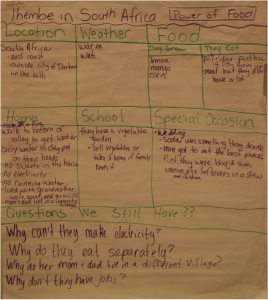
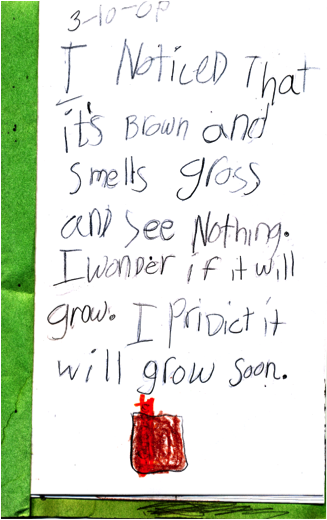
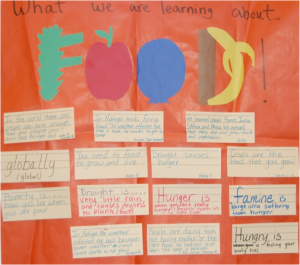
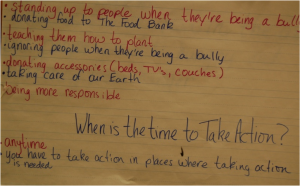
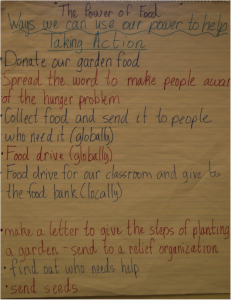
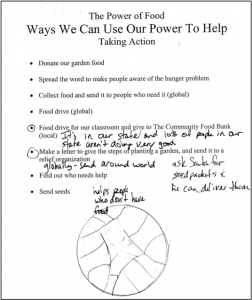
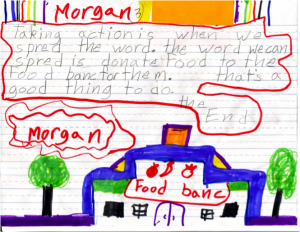
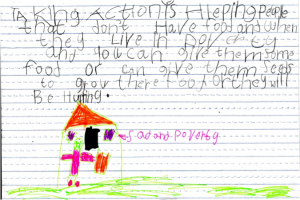
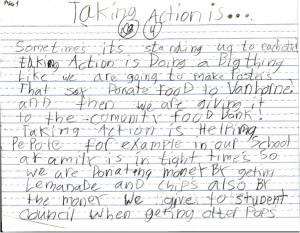

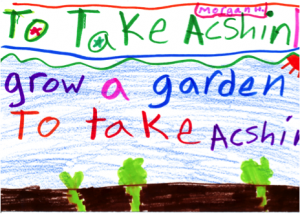
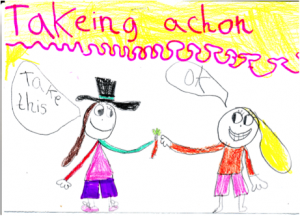
One thought on “WOW Stories: Connections from the Classroom”
Comments are closed.